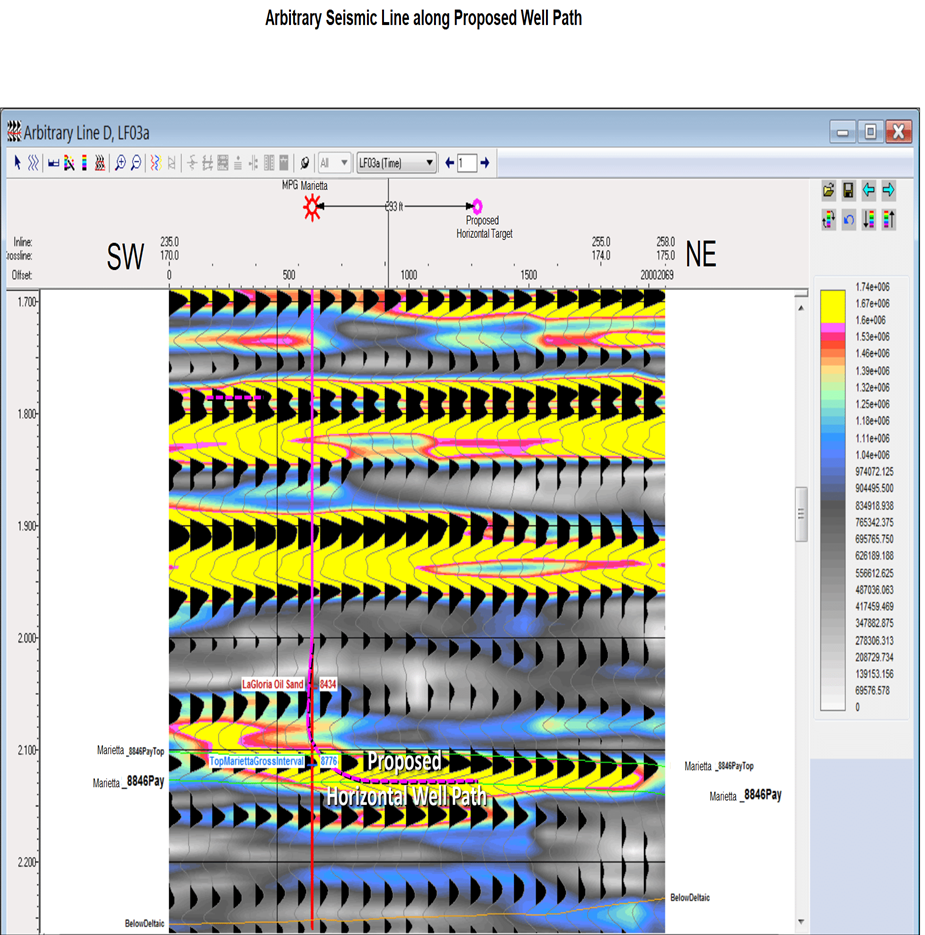Executive Summary
The Marietta Prospect
Texas Gulf Coast
Due to the highly proprietary status specific geographic information will be provided subject to a certain Non-Compete, Non-disclosure Agreement and imminent to a transaction.
MPG Petroleum, Inc. has discovered a series of stacked, hydrocarbon bearing sands that have never been produced. Charge has been proven, the hydrocarbon source rock has been identified and geochemically matched to this series of sands. The reservoirs contain (unrisked) PUD reserves of high-gravity (59 API) oil and high-Btu (1450) natural gas. Supporting data include Flow Tests, Mud Logs, Petrophysical Logs and 3D seismic data exhibiting direct hydrocarbon indicators (“DHI’s” aka bright spots or amplitude anomalies). Individual amplitude anomalies range in size from 40 to 170 acres and appear to be Deltaic Crevasse Splay (sand-shale sequence) deposits with porosity ranging from 15- 22%. The prospective reservoirs are geopressured below ~8,500 ft, with oil and gas shows present from ~5,750 ft to 9,350 ft. Several zones were perforated and flow tested at impressive rates, producing oil, natural gas and condensate but they did not sustain flow due to low porosity and permeability inherent to the reservoirs. Permeability was likely further reduced and sustained flow impeded by formation damage caused by the use of a water-based mud drilling system. Poor cement isolation is also obvious from Cement Bond Log, created by gas flow into the well during drilling operations as multiple mud weight cuts were noted in Mud Log.
The well was completed with 5.5”, P-110, 17 lb/ft casing. It is currently shut-in with 3600 Psi at the wellhead. It is a good candidate to be utilized as a Pilot Hole to cost efficiently access the by-passed resources of the series of tight oil and gas sands. A Sidetrack Lateral will be drilled from the Pilot Hole with oil-based mud and landed horizontally in the thickest and largest of the series of tight oil and gas sands, the “8900 Ft. Deltaic”. This reservoir carried the strongest show at 3102 units of gas (Mud Log Show 9). The initial objective of the Marietta Prospect is to access and produce the PUD reserves in this reservoir, then to maximize all assets accessible from the Pilot Hole with future Sidetrack Laterals. Horizontal drilling and sand fracture stimulation of tight oil and gas reservoirs has proven successful in many other areas but MPG will be first to apply this approach to this specific area and formation. Robust flow rates and high cumulative recoveries are expected. Success will lead to expanded development of the asset. Ample infrastructure is present, creating the conditions necessary for a rapid turnaround from investment to revenue in the success case.
| Unrisked Reserves: | 965,700 BOE | (145 Ac. amplitude anomaly, 36 ft avg. thickness) |
| Net Valuation at $ 60 Oil: | $ 38,693,668 | (Net of Royalty and Tax) |
| Project Cost: | $ 3,980,750 | (D&C, GG&L) |
| Return on Investment: | 10 : 1 | (Based on $60 oil assumed over life of well) |
| Estimated Proceeds Net/Month: | $ 499,908 | (Based on 445 BOEPD, $ 60 oil) |
| Pay Out Projection: | 8 Months |
Contact: Margaret P. Graham, President • MPG Petroleum, Inc. mpgraham@mpgpetroleum.com
8700 Crownhill Blvd., Suite 804, San Antonio, Texas, 78209 * 1-210-822-7770 *www.mpgpetroleum.com
An Unconventional Approach to Tight Oil Sands
|


